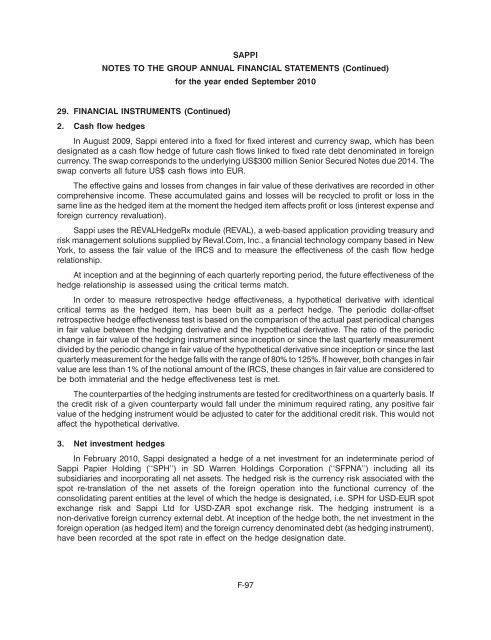Create successful ePaper yourself
Turn your PDF publications into a flip-book with our unique Google optimized e-Paper software.
<strong>SAPPI</strong><br />
NOTES TO THE GROUP ANNUAL FINANCIAL STATEMENTS (Continued)<br />
for the year ended September 2010<br />
29. FINANCIAL INSTRUMENTS (Continued)<br />
2. Cash flow hedges<br />
In August 2009, Sappi entered into a fixed for fixed interest and currency swap, which has been<br />
designated as a cash flow hedge of future cash flows linked to fixed rate debt denominated in foreign<br />
currency. The swap corresponds to the underlying US$300 million Senior Secured Notes due 2014. The<br />
swap converts all future US$ cash flows into EUR.<br />
The effective gains and losses from changes in fair value of these derivatives are recorded in other<br />
comprehensive income. These accumulated gains and losses will be recycled to profit or loss in the<br />
same line as the hedged item at the moment the hedged item affects profit or loss (interest expense and<br />
foreign currency revaluation).<br />
Sappi uses the REVALHedgeRx module (REVAL), a web-based application providing treasury and<br />
risk management solutions supplied by Reval.Com, Inc., a financial technology company based in New<br />
York, to assess the fair value of the IRCS and to measure the effectiveness of the cash flow hedge<br />
relationship.<br />
At inception and at the beginning of each quarterly reporting period, the future effectiveness of the<br />
hedge relationship is assessed using the critical terms match.<br />
In order to measure retrospective hedge effectiveness, a hypothetical derivative with identical<br />
critical terms as the hedged item, has been built as a perfect hedge. The periodic dollar-offset<br />
retrospective hedge effectiveness test is based on the comparison of the actual past periodical changes<br />
in fair value between the hedging derivative and the hypothetical derivative. The ratio of the periodic<br />
change in fair value of the hedging instrument since inception or since the last quarterly measurement<br />
divided by the periodic change in fair value of the hypothetical derivative since inception or since the last<br />
quarterly measurement for the hedge falls with the range of 80% to 125%. If however, both changes in fair<br />
value are less than 1% of the notional amount of the IRCS, these changes in fair value are considered to<br />
be both immaterial and the hedge effectiveness test is met.<br />
The counterparties of the hedging instruments are tested for creditworthiness on a quarterly basis. If<br />
the credit risk of a given counterparty would fall under the minimum required rating, any positive fair<br />
value of the hedging instrument would be adjusted to cater for the additional credit risk. This would not<br />
affect the hypothetical derivative.<br />
3. Net investment hedges<br />
In February 2010, Sappi designated a hedge of a net investment for an indeterminate period of<br />
Sappi Papier Holding (‘‘SPH’’) in SD Warren Holdings Corporation (‘‘SFPNA’’) including all its<br />
subsidiaries and incorporating all net assets. The hedged risk is the currency risk associated with the<br />
spot re-translation of the net assets of the foreign operation into the functional currency of the<br />
consolidating parent entities at the level of which the hedge is designated, i.e. SPH for USD-EUR spot<br />
exchange risk and Sappi Ltd for USD-ZAR spot exchange risk. The hedging instrument is a<br />
non-derivative foreign currency external debt. At inception of the hedge both, the net investment in the<br />
foreign operation (as hedged item) and the foreign currency denominated debt (as hedging instrument),<br />
have been recorded at the spot rate in effect on the hedge designation date.<br />
F-97
















